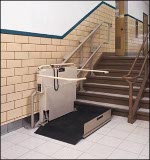Different Types of Lifting Aids
Published by Stephen on November 10, 2011 When someone is elderly, it is not uncommon for certain factors, such as age, bone density, or joint discomfort to result in making it difficult to get around. These losses of mobility are often caused by diseases like arthritis, which in many cases specifically target the joints, making bending and using them painful. In cases where a senior has difficulty bending their knees or is otherwise mobility challenged, it often becomes quite difficult to use the stairs.
When someone is elderly, it is not uncommon for certain factors, such as age, bone density, or joint discomfort to result in making it difficult to get around. These losses of mobility are often caused by diseases like arthritis, which in many cases specifically target the joints, making bending and using them painful. In cases where a senior has difficulty bending their knees or is otherwise mobility challenged, it often becomes quite difficult to use the stairs.
Using the stairs presents a number of difficulties to a senior or someone who is mobility challenged, more so than any other area in the home. Further, the most serious falls for seniors, in regards to hospitalization and injury, occur on staircases. Despite this, not using a staircase in a home is many times not an option or results in the significant loss of a homes area.
To help address this issue and make their staircase not just easier to use, but also safer, many turn to home medical equipment, like stair lifts, residential elevators, or inclined platform lifts. The type of durable medical equipment used varies, depending on the budget of the user, the environment where it is needed, and the specific needs of the handicapped individual.
Devices Reviewed:
Stair Lift Description and Use Case
 Seniors who are able to walk on their own or use a walker, such as a rollator, may be best suited to use a traditional stair lift, also called a stair chair. Stair lifts are a type of home medical equipment that is installed directly onto a staircase, providing a means of carrying the user to the top of the staircase, as well as back down, with little interaction on their part.
Seniors who are able to walk on their own or use a walker, such as a rollator, may be best suited to use a traditional stair lift, also called a stair chair. Stair lifts are a type of home medical equipment that is installed directly onto a staircase, providing a means of carrying the user to the top of the staircase, as well as back down, with little interaction on their part.
For example, the most common type of stair lift uses a chair that is installed onto a metal track. The chair slowly moves along the track, powered by an electric motor and controlled by a simple hand control attached to the chair. Obstacles, such as a purse or basketball, that are left on the stairs will trigger a simple object detection system in the footrest of the chair, causing it to stop and preventing injury or damage to the stair chair.
For a sitting stair chair lift, the seat is typically around the size of an office chair, although this varies by model and design. There are several heavy duty stair lifts, designed to accommodate more weight and a larger user, which have a much bigger seat. The handrests will usually move up and down and depending on the model, some stair chairs have varying levels of cusionioned seating, as well as offering different fabric choices.
Using a sitting stair lift, or depending on the needs of the senior, a standing stair lift can significantly improve accessibility at home, while promoting a safe and easy way to use the stairs. From a cost perspective, stair lifts are usually the least expensive type of home medical equipment and are significantly less expensive than a residential elevator.
Inclined Platform Lift Description and Use Case
 For some, especially those that use a wheelchair or mobility scooter, it is not possible or practical to use a stair chair lift. It may also be the case that a business or school wants to install a stair lift for some of their students to be able to use, but want to offer more flexibility in who can use it and not just restrict it to a certain group of mobility challenged individuals. In these sorts of situations, an inclined platform lift often offers the best and least expensive solution.
For some, especially those that use a wheelchair or mobility scooter, it is not possible or practical to use a stair chair lift. It may also be the case that a business or school wants to install a stair lift for some of their students to be able to use, but want to offer more flexibility in who can use it and not just restrict it to a certain group of mobility challenged individuals. In these sorts of situations, an inclined platform lift often offers the best and least expensive solution.
Inclined platform lifts are similar to stair lifts, with the exception of providing a much larger platform, which is typically surrounded on four sides by walls or at minimum a large lip around the edges and guard rails at hand level. While some stair lifts offer a small platform, often called a perch lift, the platform is much smaller and usually only big enough to stand on, whereas an inclined platform lift can accommodate a full-sized wheelchair and still have room left over.
Aside from the size of the platform and the surrounding walls, inclined platform lifts operate very similarly, moving along a metal track that runs the length of the staircase. Of course, the track is typically attached to the wall and not the staircase, as is the case with certain stair lift models.
Since the platform is quite large, wheelchair users and those who rely on mobility scooters to get around can easily drive their mobility vehicle onto the lift and then use it to move up or down the stair case. It can also accommodate standing riders, with most devices offering easy to grasp hand rails and, in some instances, a small fold down seat. Depending on the model, most will also fold up when not in use, to take up less space, however not all models can be folded up.
Since inclined platform lifts are able to accommodate a number of differ t people in varying stages of mobility, it is often the choice for schools and other commercial settings. Although, it is important to keep in mind that commercial inclined platform lifts must meet a few extra requirements, such as an operational lock on the actual unit, as well as other local building codes.
From a cost perspective, inclined platform lifts are still usually a good deal cheaper than installing an elevator, in large part due to the reduced installation costs, however they are more expensive than stair lifts.
Residential Elevator Description and Use Case
 Of the three stair case solutions described, residential elevators are by far the most expensive option. With that said, they often offer a much more convenience and functionality than the other solutions.
Of the three stair case solutions described, residential elevators are by far the most expensive option. With that said, they often offer a much more convenience and functionality than the other solutions.
Residential elevators are usually very similar to commercial elevators, with the exception of their size and the way their door works. Most residential elevators are much smaller, usually the size of a standard closet and instead of having automatically closing hydraulic doors, it is not uncommon for them to have a standard shutting door or a pull shut gate.
Due to their reduced size and propulsion system, which is usually attached in the roof of the home, sometimes without requiring additional reinforcement, residential elevators also support less weight than their commercial counterparts.
While using an elevator in the home is usually a more expensive option, it does offer several advantages. One advantage is that they do not take up any space on the staircase, unlike stair lifts or inclined platform lifts, which are typically installed directly onto the staircase. Residential elevators also add more value to the home and become a key reselling feature, in addition to making it significantly easier to not just get up the stairs, but also move items between floors. Like inclined platform lifts, residential elevators are great for those who use wheelchairs or other types of mobility vehicles.
The main cost of a residential elevator is typically in the installation, although the elevator itself is also quite expensive.
Since elevators are usually installed to a shaft, but many are retro-fits, which is to say the elevator is being installed after the home is built, it is often necessary to customize the home to accommodate the elevator shaft. In many instances, a hallway closet can be configured to house the elevator shaft, although there will still be a good deal of customization between floors and on the interior of the wall structure, including possibly moving pipes, electric components, and support beams in the home, to allow travel between floors.
Final Thoughts on Residential Lifting Products
As is the case in many situations the literal needs of the individual using the device and the budget involved will usually offer the biggest indicator on what type of lifting device will work best in the home.
The stair lift, by far, usually offers the most economical solution, as on a straight staircase, a do-it-yourself stair lift kit will usually cost less than $2000. These work great for those who are able to stand and sit on their own, however, will not work in all cases, especially for those who use wheelchairs.
Inclined Platform Lifts fall in between on a cost perspective and work great for people who use mobility vehicles, like wheelchairs, power chairs, or mobility scooters. They also are a nice option for schools and other businesses, as a commercial inclined platform lift can accommodate the largest group of people with special needs, including not just those who use mobility vehicles, but also those with difficulty walking.
One of the main advantages of both inclined platform lifts and stair lifts is that they can easily be installed to most staircases, without major modification and often by the home owner. For residential use, a building permit is typically not needed, although it is a good idea to check your local building codes first, as some states, specifically Washington and Connecticut, may have special regulations on installing these types of lifts.
The point where stair lifts begin to loose value is on complicated staircases, such as curved stair cases or ones that have uneven bends or platforms. In these sorts of cases, a more complicated stair lift setup is often needed, making it more expensive. This is also true of inclined platform lifts, although typically the installation of the track for an inclined platform lift occurs on the wall and not the staircase treads, like most stair lifts. So, inclined platform lifts are typically already more difficult to install.
Residential elevators, on the other hand, will require much more planning and home modification, usually not just requiring building permits, but also the use of a general contractor. While from a functionality standpoint, residential elevators are often a very nice choice, especially since they do not take up any space on the staircase, they are usually much more expensive than other devices. It is possible to retro-fit a home with an elevator, but it is easiest if the home is built with installation of the elevator in mind.
No Comments |
Add a Comment